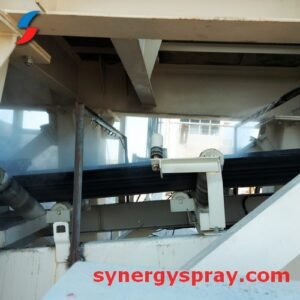Description
A dust suppression misting system works on the principle of atomization. Water is pressurized (typically between 50–200 bar) and forced through specially designed nozzles that break the water into micron-sized droplets (usually 10–50 microns). These fine droplets interact with dust particles and cause them to settle without creating excess water on surfaces.
Our misting systems provide with extremely effective solutions to airborne dust suppression and air filtration
High pressure misting systems are the most appropriate solution indoor small and large areas to suppress dust generated by materials handling or manufacturing processes in general.
Synergy Spray Systems Misting systems create a high concentration of ultra thin water droplets with an average diameter of 10 microns having the ability to capture and suppress PM10 and smaller particles. Water droplets instantly blanket suspended dust particles, increasing their weight and driving them to the ground.
BENEFITS
- Easy and fast installations
- Automatic functioning
- Cleanable nozzles
- Minimum maintenance
- Low water consumption
- Adherence to environmental standards
- Reduces environmental impacts
- lower labour costs
- better working conditions
- lower wearing of machinery and tools
- lower environmental pollution
- effective dust suppression on open spaces
- Longer life of machines
Key Components
High-Pressure Pump: Provides consistent water pressure for effective atomization.
Misting Nozzles: Designed to create ultra-fine droplets for dust capture.
Filtration System: Ensures clean water to prevent nozzle clogging.
Control Panel: Allows automation with timers, sensors, and remote operation.
Piping Network: Stainless steel or nylon tubing for water distribution.
Applications
Mining & Quarrying: Reduces silica and coal dust emissions.
Cement Plants: Controls dust at crushers, conveyor transfer points, and stockyards.
Construction Sites: Keeps dust levels low during demolition and excavation.
Bulk Material Handling: Controls dust in coal, iron ore, limestone, and grain handling.
Recycling Plants & Landfills: Manages dust in waste handling and processing units.
Benefits
Health & Safety Compliance: Reduces respiratory hazards and meets environmental norms.
Eco-Friendly: Uses minimal water compared to traditional spraying methods.
Cost-Effective: Low operating cost and reduced need for chemical suppressants.
Improved Visibility: Enhances site safety by reducing dust clouds.
Automation Options: Sensors for dust detection and automatic misting.
Types of Dust Suppression Misting Systems
High-Pressure Mist Systems (50–200 bar) – For large outdoor areas.
Low-Pressure Systems (10–50 bar) – For localized dust control.
Mobile Fog Cannons – Portable units for flexible applications.
Fixed Fogging Systems – Installed in transfer points and hoppers.
Industries Using Dust Suppression Systems
Mining & Quarrying
Steel Plants
Power Plants (Coal Handling)
Cement & Aggregate Processing
Food & Grain Handling Units
Construction & Demolition Sites






Reviews
There are no reviews yet.